Refinishing vs Replacing Your Hardwood Floors
09/30/2025
Reading Time ~ 9 minutes
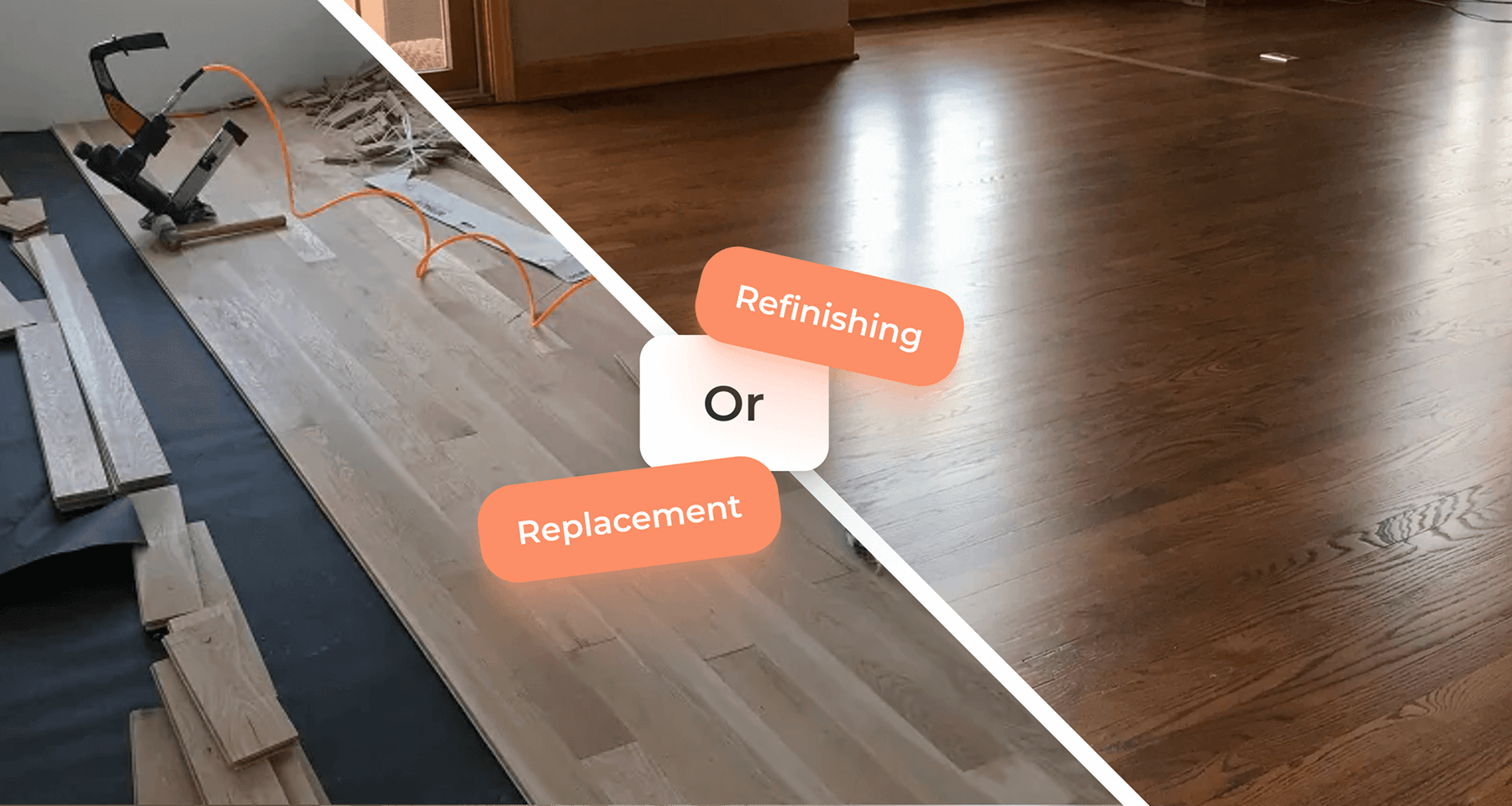
Table of Contents
- Should I Refinish or Replace Hardwood Floors?
- Is It Cheaper to Refinish or Replace Hardwood Floors, And How Long Does Each Take?
- Will Wood Floor Damage Push Me to Replace or Refinish?
- Can I Do Partial Repairs or a Quick Screen & Recoat Instead of Full Refinishing?
- Can Refinishing Change the Color Enough, Or Is Replacement Better For the Look I Want?
- When Replacing Hardwood Floors Beats Refinishing
Should I Refinish or Replace Hardwood Floors?
Refinish when the wood is sound and the problem is surface-level wear; replace when there’s widespread moisture deformation, structural movement, delamination, or the wear layer is too thin to sand safely (especially on engineered floors). Floors that meet the refinishability threshold (≈3/32″ / 2.5–3.2 mm wear layer) are fair candidates for sanding; below that, you risk sanding through.
Signs It’s Refinishing: Finish Wear, Scratches, Dull Traffic Lanes, Sound Subfloor
Choose hardwood floor refinishing if damage is cosmetic and boards/subfloor are stable.
- Finish is worn, color looks tired, there are light-to-moderate scratches, but no exposed nails or loose boards.
- No active moisture problems: no progressive cupping/crowning and certainly no buckling.
- Subfloor feels solid; fasteners hold; movement is minimal; gaps are seasonal, not structural.
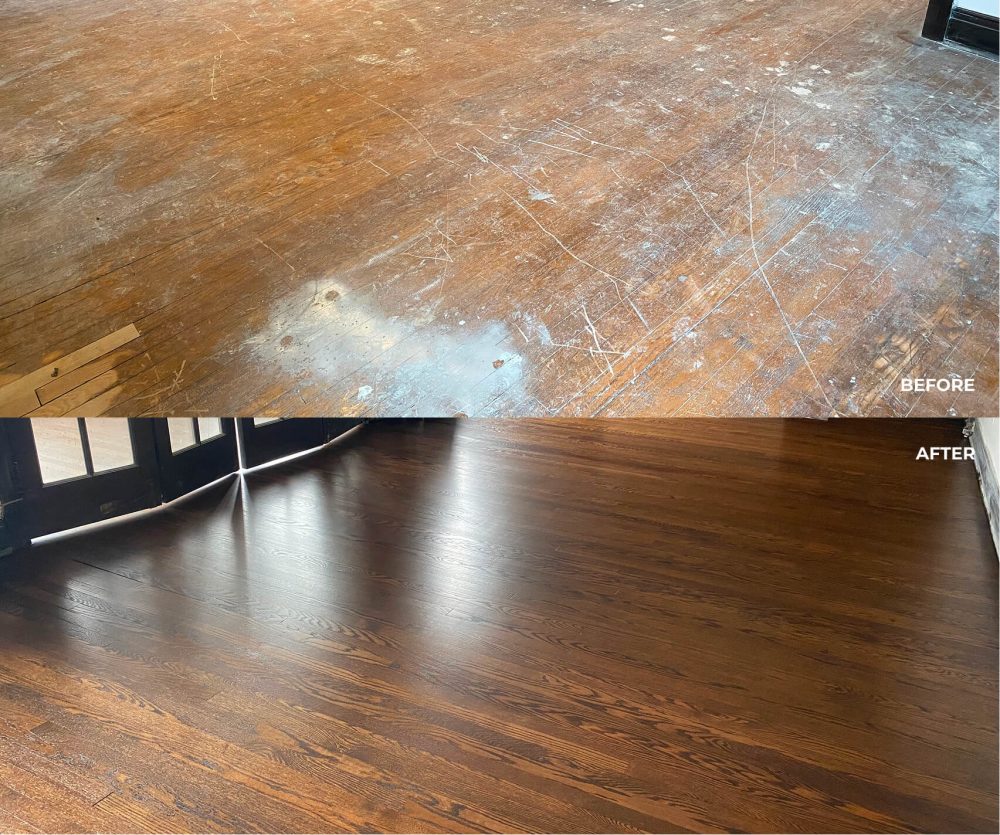
Signs It’s Replacement Time
Replace when the wood has moved or failed beyond what sanding can flatten, or when thickness is already “to the nails.”
Red flags that push to replacement:
- Moisture deformation: persistent cupping/crowning, any buckling (lifted boards).
- Engineered failures: veneer delamination or telegraphing core; veneer too thin for a safe resand.
- Thickness issues: visible nails, tongue almost exposed, or confirmed wear layer below ≈3/32″.
- Structure: loose/creaking subfloor, widespread pet/black stains across rooms, or repeated leak history.
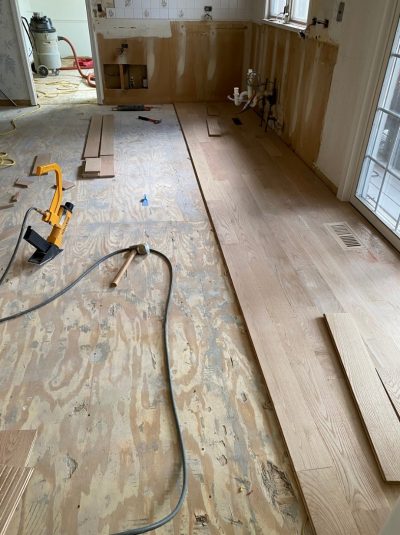
Can I Refinish Engineered Hardwood?
Yes—if the top wood veneer is thick enough; NWFA’s refinishable criteria center around ~3/32″ (≈2.5 mm finished, 3.2 mm unfinished). Solid hardwood can take multiple sandings until the tongue/groove is approached; engineered depends entirely on veneer thickness.
- Inspect a floor register/threshold cross-section or a leftover plank; measure the wear layer (the real wood above the ply/core).
- Look for the NWFA Refinishable mark on engineered products; it denotes minimum wear-layer standards designed for at least one professional resand.
Is It Cheaper to Refinish or Replace Hardwood Floors, And How Long Does Each Take?
Refinishing is typically the cheaper, faster path—often about $3–$8 per sq ft—while new hardwood installed commonly runs about $6–$25 per sq ft plus any tear-out/disposal, so total costs climb quickly. Timelines vary, but wood floor refinishing is usually a 3–5-day workflow plus cure; replacement adds demolition/hardwood installation days.
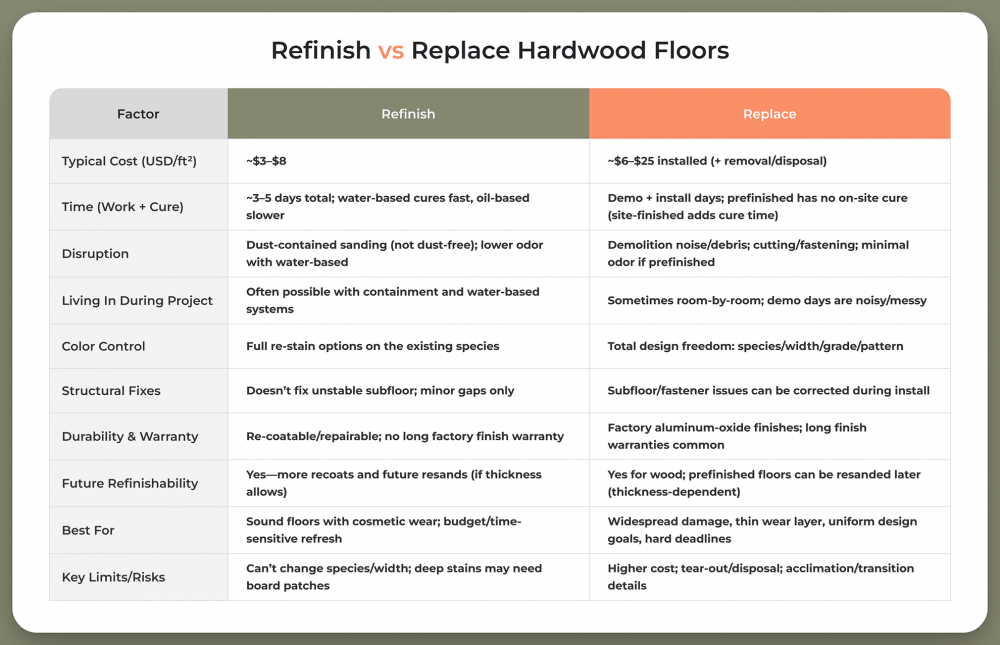
Cost To Refinish vs Replace
Expect refinishing costs to be something around $3–$8/sq ft (condition and finish system drive it) vs replacement ≈ $6–$25/sq ft installed, with tear-out/disposal adding roughly a few dollars per sq ft.
What swings price most:
- Refinish: square footage/rooms, repair patches, stain complexity, water- vs oil-based polyurethane system.
- Replace: wood species and grade, plank width/length, install method (glue vs nail), removal/disposal and subfloor prep.
Timeline & Cure Windows
A typical refinish spans 3–5 workdays; water-based pro finishes reach high initial cure in ~24–72 h and full cure in days, while oil-modified systems dry/cure slower.
- Water-based (e.g., Bona Traffic HD): recoat in 2–3 h; ~80% cured at 24 h, 100% by 3 days; area rugs typically after ~1 week.
- Oil-modified polyurethane: longer dry/cure and stronger odor; plan for slower furniture/rug return.
Can We Live in The Home?
Many households stay—modern dust-contained sanding captures most particles and water-based finishes limit odor, but no system is truly dust-free.
- Dust-contained sanding routes dust to HEPA vacuums, yet a trace remains—plan light wipe-downs.
- Water-based polyurethane = lower odor/faster return; oil-based = richer amber tone but stronger smell and longer cure.
For pre-1978 homes, we perform work under the EPA’s Lead-Safe Renovation, Repair and Painting (RRP) Rule—dust containment, lead-safe work practices, and post-work cleaning verification
If you are concerned about your health, it’s better to stay out of the home during hardwood floor refinishing.

Long-Term Value & Durability
Many factory-finished hardwoods use UV-cured aluminum-oxide topcoats with long finish warranties (often ~20–25 years), which can help resale. On-site polyurethane is highly serviceable and re-coatable, but it isn’t packaged with the same long, written finish warranties. If you want warranty-backed wear resistance out of the box, new prefinished boards win; if you value repairability and preserving original wood, refinishing wins.
Will Wood Floor Damage Push Me to Replace or Refinish?
If damage is mostly cosmetic and the floor structure is stable, it’s usually smarter to refinish; ongoing moisture problems, pervasive black stains, buckling, delamination, or a too-thin wear layer tilt the call toward replacement.
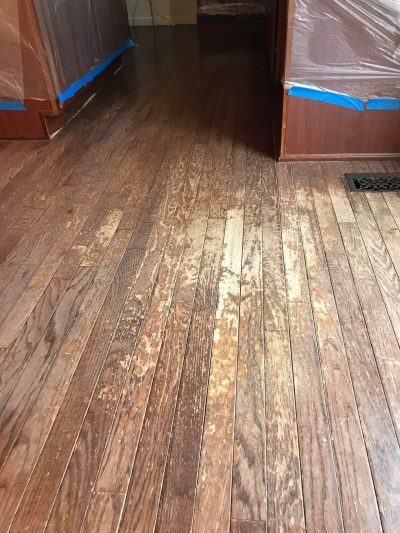
Water Issues: When Sanding Works Vs When Replacement Is Unavoidable
Minor cupping after a one-off spill can sometimes be sanded flat only after the wood has fully dried and stabilized; persistent crowning or any buckling typically requires replacement (and often subfloor repair).
Once moisture is under control, check that the boards have returned to a steady indoor moisture level before deciding.
If edges stayed swollen or the core has swelled (common on engineered), sanding won’t “un-warp” the geometry. Think of water-warped boards like a book left in the rain—drying helps, but the ripples rarely press perfectly flat.
Pet/Black Stains: When to Patch Boards + Refinish Vs Full Replacement
Sanding can lighten some dark marks, but urine and iron-tannin reactions often penetrate past the top layer, so affected boards usually need replacing, then a whole-room refinish to blend sheen and color.
If stains are localized, board patches plus refinishing work well; when staining is widespread across rooms or along seams, full replacement is typically more time- and cost-effective than chasing dozens of patches.
Deep Dents, Nails Showing, Gaps/Squeaks
Sanding removes shallow compression marks, not craters; if nail heads or tongues are already visible, there isn’t enough wood left to resand safely—replace.
NWFA guidance ties ‘nails showing / tongue exposed’ to an insufficient remaining wear layer; once you’re under ~3/32″, a professional resand is not recommended.
Squeaks and bouncy spots come from movement below the surface; refinishing doesn’t tighten a loose subfloor or weak fasteners. Static, narrow gaps can be managed during a full sand & finish; moving or wide gaps tend to crack filler and point to fastening/subfloor work or sectional replacement.
Can I Do Partial Repairs or a Quick Screen & Recoat Instead of Full Refinishing?
Yes—if the finish is intact and the wood isn’t exposed, a screen & recoat can refresh sheen and protection fast, and if damage is local you can replace a few boards and then refinish to unify the look. This keeps disruption low while you avoid the cost and dust of a full sand.
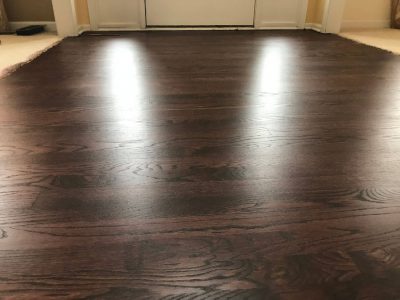
Replace A Few Boards + Refinish to Match
Board patching plus a room-wide sand & finish can make old and new blend convincingly, but species, grade, age, and sun-fade set the ceiling for “invisible.” Prefinished micro-bevels, UV-aged areas, or heavy prior stains may still telegraph slight tone or edge differences even after a careful refinish.
When A Recoat Is Enough vs Full Sand & Finish
Recoat is a top-coat refresh: it works when there’s no bare wood, no wax/oil contamination, and scratches haven’t cut through the finish; you abrade the existing coat and apply a new one. It won’t fix gray traffic lanes, deep gouges, or flatten ridges—those need a full sand & finish.
Properly done, a recoat can buy several more years of service in typical residential traffic; if you want a new color or to erase wear patterns, go straight to a full refinishing.
Can Refinishing Change the Color Enough, Or Is Replacement Better For the Look I Want?
Wood floor refinishing can shift most hardwood floors dramatically—dark to light or light to dark—because a full sand removes the old finish and lets you restain and change color; replacement is better when the “look” you want depends on species, width, grade, texture, or pattern that sanding can’t create.
How Far You Can Go
You can usually go several shades either direction with a full sand and stain; the limiting factors are species (e.g., maple vs oak grain), prior deep stains, sun-fade, and your chosen finish system. Water-based poly keeps tones closer to raw wood and cures fast; oil-modified warms/ambers the color and cures slower—great for depth, not for speed.
- Dark → Light: achievable after a full sand; lingering urine/iron-tannin marks may still ghost and need board replacement.
- Light → Dark: easy with stain, but very dark tones show dust and foot traffic sooner—beauty traded for maintenance.
- Sheen & texture: matte hides wear best; high-gloss magnifies defects; wire-brushed/hand-scraped textures aren’t produced by standard sanding.
When Replacement Is the Aesthetic Shortcut
If the goal is wide planks, a different species (say, walnut instead of oak), a cleaner/knottier grade, bevelled edges, or a pattern (herringbone/chevron), replacement is the direct path; refinishing can’t change those fundamentals.
Think of refinishing as repainting the same bodywork, while replacement lets you swap the body panels—color vs architecture. One more lens: character/patina vs uniformity—refinishing preserves the original wood’s story; replacement buys a flawless, consistent canvas.
When Replacing Hardwood Floors Beats Refinishing
Replacement wins when structure, thickness, or scope make sanding risky or when you need factory-finished durability and a uniform, warrantied result under tight deadlines.
Strongest Cases for Replacement
If the wear layer is too thin (engineered veneer or solid near the tongue), sanding risks failure; if the subfloor moves, squeaks, or is water-damaged, finish work won’t fix the root cause.
Widespread buckling/crowning or pervasive black stains across rooms tip cost and time toward a new install, and hard timeframes often favor prefinished floors with no on-site cure. Design targets that require new species/width/grade or patterned layouts are also squarely in the replace camp.
- Risk reduction: new boards + subfloor fixes remove unknowns that hardwood refinishing would merely mask.
- Schedule control: demolition/installation is noisy but predictable; prefinished products avoid on-site cure windows.
- Aesthetic certainty: grade, color, bevel, and pattern arrive exactly as specified.
Why Refinishing Still Wins on Sound Floors
On sound, flat floors, refinishing usually delivers the desired update faster and at a lower total cost while allowing meaningful color changes and future recoats.
You keep the existing plank species/width/grade, but you also keep original material that’s repairable—much like restoring a classic car’s paint and interior instead of buying a new model: less new hardware, more value from what you already own.
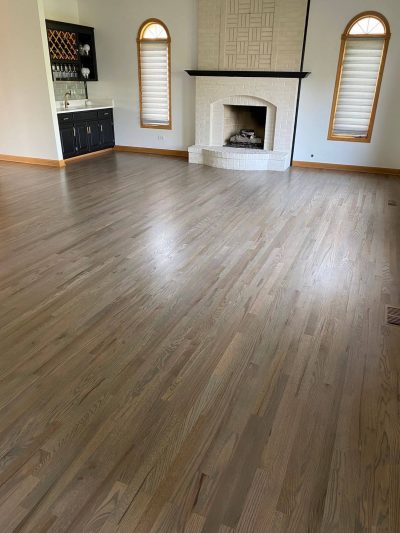
Conclusion
Refinish when the wood is sound and the issues are cosmetic; replace when damage is structural, widespread, or when the look you want (species/width/grade/pattern) can’t be sanded into the floor you have. Refinishing is usually faster and less expensive, while replacement trades higher cost for factory-finish warranties and total design control. Hope this helps you decide!
frequently asked questions
Is DIY refinishing a mistake?
Often, yes. Drum-sander gouges, poor adhesion, and product mismatch are common; failed DIY jobs cost more to fix than hiring a pro upfront.
Water-based vs oil-based polyurethane — what’s the practical difference?
Water-based cures faster with lower odor and keeps a clearer tone; oil-based ambers the color, smells stronger, and cures slower but can add visual depth.
Can you refinish engineered hardwood floors?
Yes you can refinish engineered hardwood, if the wear layer is thick enough (roughly 2.5–3 mm or more). Thin veneers can’t be safely sanded; many engineered floors allow only one full resand.
How many times can you sand and refinish solid hardwood?
Typically two to four (or more) times for ¾-inch solids, depending on past sanding and how close you are to the tongue/groove or nail heads.
If nails are already showing, is replacement mandatory?
For widespread areas, yes — there isn’t enough wood left to sand. Small isolated spots can sometimes be patched, but extensive nail show means replace.
Does refinishing fix minor seasonal cupping/gaps?
Not the cause. Minor cupping can be sanded flat after the wood re-equilibrates; recurring gaps are best managed with humidity control, as filler tends to crack if boards keep moving.
Overall rating
5





(1 vote(s))

 4.9
4.9





 Donatas
Donatas
Comments